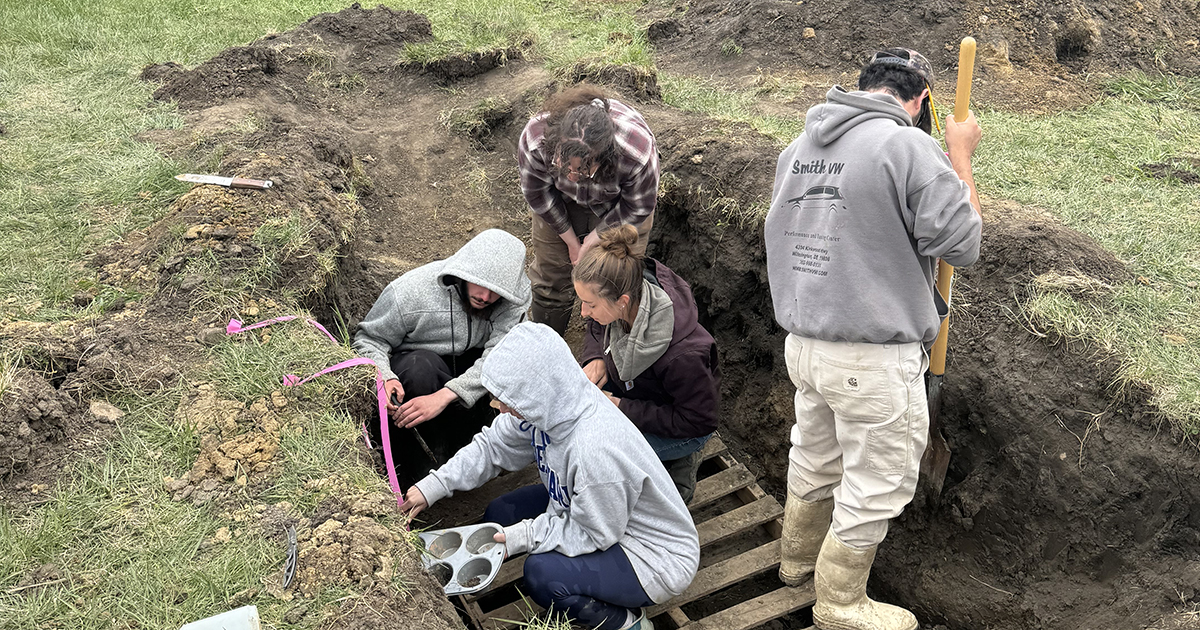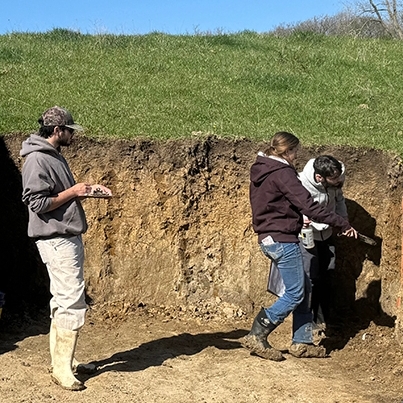
Category: Plant and Soil Sciences

Student soil analysts
June 17, 2024 Written by Nya Wynn | Photos courtesy of Brielle Carter
After winning its regional competition, a team of University of Delaware students recently placed eighth in a national soil judging competition in Iowa.
These undergraduate students spent hours analyzing five-foot-deep soil pits, showcasing their knowledge of different soil types, levels of water retention and the geological history of the soil.
“Soil judging is a way of describing the history of the soil in the pit,” said Brielle Carter, a sophomore agriculture and natural resources major with a soil science minor. “You know if you’re at the bottom of the slope, things are gonna tumble down. You have to think about other factors about the land and the ponding and flooding in the area.”
Students must analyze each top layer of soil – called a soil horizon – within their pit and based on that come to different conclusions about the history of the area and what the best use of that soil type would be.
“There are different characteristics present within each horizon, and then based on what you saw in those horizons, you go into classifying the soil,” said Bethany Knutsen, sophomore plant science major with a minor in soil science. “We also go into site interpretations, so based on the information that we saw, we can determine if it would be good for a basement or if it’s prime farmland.”
Knutsen discovered soils judging through her mother, who works for the soil conservation district. The UD Class of 2026 undergraduate student spoke with several soil scientists about future job opportunities in the soil sector. The Delaware native said that multiple people told her ‘if you want to go into soils, take part in soil judging.’
UD’s soil judging team won its regional competition in Pennsylvania during the fall semester. In April, the team traveled to Ames, Iowa to compete for the national title. In doing so, they had to change the way they thought about the soil.
“Soils are very classified by region, so going out to the Midwest was a completely different ballgame,” Carter said.
The students knew the competition would be close to Iowa State University, the competition’s host. The team’s coaches Phil King, the Natural Resources Conservation Service (NRCS) State Soil Scientist for Delaware and Maryland, and Jenwei Tsai, a senior project scientist at Verdantas, were able to look up the different soil types that were present in the area to create “practice pits'' for the team similar to what they’d see in Iowa.

“To prepare for the competition, I pulled every single soil that is mapped [in the region] from published literature and I broke it down by acreage mapped,” Tsai said. “Then we went through the whole series to familiarize the students with the types of soil. We also have archived soil samples so they can practice looking at texture and color, but a lot of what we do is when we get there.”
Both King and Tsai come from a rich background in soil, and have a lot of useful insights to offer the team.
“[King] is a professional in soils, that is essentially his entire job,” Knutsen said. “And [Tsai] works for a private company that works with soils, so judging soils is relevant in both of their careers. Since they’re in the field so often, that gives us a leg up.”
“It’s supportive for students to see soil scientists in the real world,” added Tsai. “I think it can be an advantage because sometimes we see things from more of a real world perspective, so on top of trying to teach what we're seeing in the field, we're teaching the textbook content.”
To get further acclimated to the midwest soils, teams traveled out three days early prior to the competition to do practice pits provided by the host university.
“When we first get to a pit the main thing is you will want to break up the soil horizons then we take samples of those and each horizon will have different colors and texture and coarse fragments that we log,” Knutsen said.
Soil judging requires a variety of knowledge, from geology to chemistry. Students investigate how much oxygen is present in the soil and the water tables, which is the boundary between water-saturated ground and unsaturated ground in the pit. Because of the expansive amount of knowledge students have to pull from in order to classify soils in their pit, soils judging has a lot of practical applications.
Tsai explained that since students are able to meet other soil scientists and students in the field during the national competition, it’s a great networking opportunity as well. Students on the team not only are gaining hands-on experience in their desired career field, but they can meet others who are interested in the same things and network.
“Some of my former students are working in governmental organizations and some in the private sector,” Tsai said. “It is helpful for them to network while also being able to apply what they learned in the classroom.
“Since we also get to travel to different places, students are seeing that if you have skills in this field, you can get a job anywhere,” she added.
Students on the team are already putting their knowledge into practice with summer internships.
“There's a lot of careers out there that involve soils,” Carter said. “This summer, I’m working for an agronomist and I'll be doing a lot of soil sampling, so soil judging is really great experience. Especially just getting some fieldwork in because it’s an intensive thing.”
“I have a job lined up this summer with my soil judging coach who works for NRCS as a soil scientist,” highlighted Knutsen. “I'm hoping things are good this summer and I can look into that as my future pathway and future career.”

